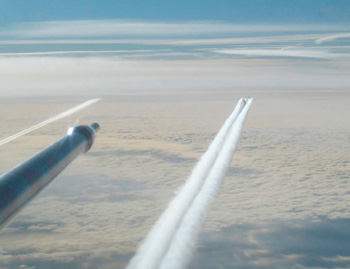2011 News & Events
Chasing Contrails: Pinning Down Their Effect on Climate
14 July 2011

A recent study coauthored by CSD scientists David Fahey and Troy Thornberry with European colleagues used a research aircraft to investigate the climate-related properties of contrails, the wispy white trails that sometimes form in the atmosphere behind aircraft. They directly sampled 14 contrails within 10 minutes of their formation behind nine different commercial aircraft, as part of the CONCERT (CONtrail and Cirrus ExpeRimenT) campaign in November 2008.
The climate influence of contrails is not well quantified; neither is the associated cloudiness induced by aircraft. Ice particles form when the soot and particles emitted in aircraft exhaust mix with the ambient air. The evolution of the particles, and the transformation of the contrail to cirrus clouds, depends on many aspects of the local atmospheric environment. Very few observations of contrails exist, and the new study gives the most information to date on the properties of "young" contrails and their evolution in the atmosphere.
The new study gives a globally representative, year-2000 linear contrail radiative forcing of 13.5 mWm-2, which confirms the value given in the latest IPCC report (10 mWm-2) and now places the estimate on a much more substantial observational and theoretical basis. Although the authors speculate that the aircraft they measured are reasonably representative of the current global fleet, they conclude that "further measurements and global model simulations are required to better constrain the radiative forcing from contrails in a present and future climate."
C. Voigt1,2, U. Schumann1, P. Jessberger1, T. Jurkat1, A. Petzold1, J.-F. Gayet3, M. Krämer4, T. Thornberry5 and D. W. Fahey5, Extinction and optical depth of contrails, Geophysical Research Letters, doi:10.1029/2011GL047189, 2011.
- Institut für Physik der Atmosphäre, Deutsches Zentrum fuür Luft- und Raumfahrt, Oberpfaffenhofen, Germany
- Institut für Physik der Atmosphäre, Johannes-Gutenberg University, Mainz, Germany
- LaMP, University Blaise Pascal, Clermont-Ferrand, France
- IEK-7, Institute for Energy and Climate Research, Forschungszentrum Juülich, Juülich, Germany
- Chemical Sciences Division, Earth System Research Laboratory, National Oceanic and Atmospheric Administration, Boulder, Colorado, USA
Abstract
One factor limiting the understanding of the climate impact from contrails and aircraft induced cloud modifications is the accurate determination of their optical depth. To this end, 14 contrails were sampled for 2756 s with instruments onboard the research aircraft Falcon during the CONCERT (CONtrail and Cirrus ExpeRimenT) campaign in November 2008. The young (<10 min old) contrails were produced by 9 commercial aircraft with weights of 47 to 508 t, among them the largest operating passenger aircraft, the Airbus A380. The contrails were observed at temperatures between 214 and 224 K and altitudes between 8.8 and 11.1 km. The measured mean in-contrail relative humidity with respect to ice was 89 ± 12%. Six contrails were observed in cloud free air, the others were embedded in thin cirrus clouds. The observed contrails exhibited a mean ice water content of 2 mg m-3 and had a mean number concentration of 117 cm-3 and effective radius of 2.9 μm assuming asphericle particles with an aspect ratio of 0.5. Probability density functions of the extinction, with a mean (median) of 1.2 (0.7) km-1, and of the optical depth τ, with a mean (median) of 0.27 (0.13), are derived from the in situ measurements and are likely representative for young contrails from the present-day commercial aircraft fleet at observation conditions. Radiative transfer estimates using the in-situ measured contrail optical depth lead to a year-2005 estimate of line-shaped contrail radiative forcing of 15.9 mWm-2 with an uncertainty range of 11.1-47.7 mWm-2.